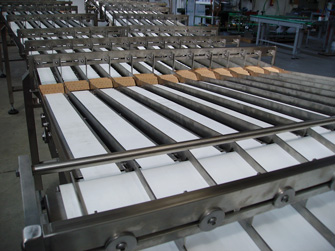 MH propone soluzioni efficienti per la produzione industriale dei biscotti e dei crackers
MH propone soluzioni efficienti per la produzione industriale dei biscotti e dei crackers
La produzione industriale dei biscotti e dei crackers, sebbene condivida molte caratteristiche con il resto dei prodotti da forno nella parte dei macchinari di processo, forno compreso, inizia subito a differenziarsi a partire dal sistema di raffreddamento del prodotto. Nel caso dei biscotti sono richiesi nastri trasportatori a tappeto, che offrano un supporto continuo o quantomeno trasportatori in maglia plastica o metallica con una trama molto fitta; in entrambi i casi si tratta di nastri lunghi con fonte largo. Non si tratta di macchinari complessi, ma le loro grandi dimensioni richiedono determinati accorgimenti che MH è in grado di applicare.
Completata la fase di raffreddamento si passa al confezionamento primario in cui troviamo tre casi esemplari: il sacchetto a fondo quadro, l’incarto o flowpack con biscotti in costa e le monoporzioni in flowpack. Ci sarebbe aggiungere il caso dei prodotti da pasticceria che di solito vengono messi in vassoi di plastica e che, come anticipato all’inizio, vede delle linee più simili a quelle dei prodotti dolciari.
I prodotti che vanno in sacchetto a fondo quadro, superato il raffreddamento, vengono scaricati in massa su nastri elevatori a facchini che vanno ad alimentare flowpack verticali. I sacchetti vanno a questo punto direttamente nell’imballo che li porterà nei punti vendita: scatole di cartone o display. Tra il confezionamento primario e il secondario è buona norma mettere un Buffer LIFO come il BAT-Buffer di MH. Una volta completato l’imballo secondario si trovano le consuete soluzioni delle linee scatole per alimentare la zona di pallettizzazione.
Un po’ più complicate le soluzioni richieste per i biscotti incartati a tubo o per le monoporzioni in flowpack. In entrambi i casi i biscotti vanno messi “in costa” (stakerati), vengono quindi sovrapposti l’uno sull’altro per mezzo di trasportatori a tappeto a passo che controllano l’arrivo di ogni singolo prodotto oppure sollevati per mezzo un tappeto in salita, fatti scendere su uno scivolo e messi in piedi per mezzo di un dispositivo a stella rotante. Le velocità di trasporto vengono gradualmente ridotte fino ad ottenere file multiple di biscotti in verticale, che poggiano sul bordo stretto, e avanzano in treni compatti fino alle macchine di confezionamento. Il medesimo procedimento è condiviso dai cracker.
Sia l’incarto a tubo che i flowpack monoporzione presentano un imballo secondario che riunisce diverse confezioni e che di solito è nuovamente un incarto o un flowpack. Qualche volta si trovano delle linee che bypassano il sovraimballo e mandino le confezioni singole in display destinati ai punti vendita più piccoli o alle aree di sosta autostradali. Tra il confezionamento primario e l’imballo secondario si trovano quasi sempre unificatori e sistemi Buffer LIFO. La fase successiva prevede come sempre incassatrici e alimentazione alla pallettizzazione e anche in questo caso MH è in grado di fornire le linee scatole, con tutte le soluzioni che le accomunano.
Crackers and biscuits packaging lines
MH proposes efficient solutions for biscuit and cracker industrial production
The industrial production of biscuits and crackers, although it shares many characteristics with the rest of the baked goods in the part of the process machinery, including the oven, immediately begins to differentiate itself starting from the product cooling system. Cooling biscuits is managed with belt conveyor, which offer continuous support or at least conveyors in plastic or metal mesh with a very dense weave; in both cases long stretches of transport on belts with a wide source are required. These are not complex machines, but their large dimensions require certain precautions that MH is able to apply.
Once the cooling phase is complete, we move on to the primary packaging in which we find three exemplary cases: the square bottom bag, the wrapping or flowpack with biscuits in slugs and the single portions in flowpack. We would add the case of pastry products which are usually placed in plastic trays and which, as anticipated at the beginning, have lines more similar to those of confectionery products.
The products that go into a square bottom bag, after cooling, are unloaded in bulk onto clamps elevators which feed vertical flowpacks. At this point, the bags go directly to the packaging that will take them to the stores: cardboard boxes or displays. Between the primary and secondary packaging, it is good practice to put a LIFO Buffer like MH BAT-Buffer. Once the secondary packaging is complete, the usual solutions of the box lines are found to feed the palletizing area.
A little more complicated are the solutions required for tube-wrapped biscuits or for single portions in flowpack. In both cases the biscuits are placed “on the edge” (staked), are then superimposed on each other by means of step conveyors that control the arrival of each individual product or raised by means of an uphill conveyor belt, get off on a slide and stand up using a wheel device. Transport speeds are gradually reduced until multiple rows of biscuits are placed vertically, resting on the narrow edge, and advancing in compact trains to the packaging machines. The same process is shared by crackers.
Both the tube wrapping and the single-portion flowpacks have a secondary packaging that brings together different packs and which is usually again a wrapping or a flowpack. Sometimes there are lines which bypass the overpacks and send the single packs on display destined for smaller sales points or motorway parking areas. Mergers and LIFO Buffer systems are almost always found between the primary packaging and the secondary packaging. As always, the next phase foresees casepackers and feeding to the palletizing, also in this case MH is capable to supply the boxes lines, with all the solutions they have in common.









